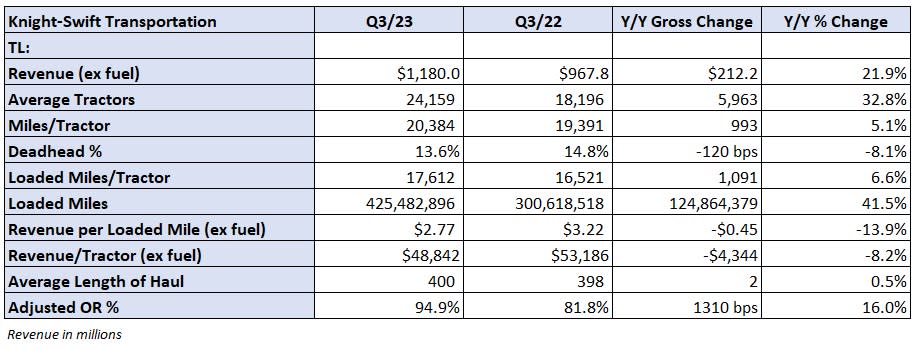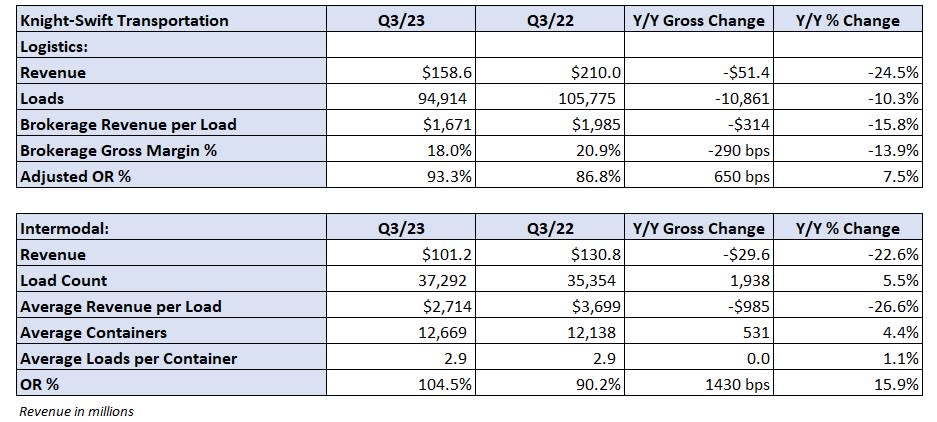Knight-Swift sees inflection coming, beats lowered Q3 expectations

Management from Knight-Swift Transportation said Thursday that a tipping point for the truckload market is close.
“It feels like the extreme aggressiveness that we have seen out of non-asset-based players has reached a level to where it’s not only unsustainable, but when you add how expensive financing is … it blows up,” President and CEO Dave Jackson told analysts on a conference call.
The comments followed an announcement earlier in the day that financially distressed digital broker Convoy was shutting down abruptly.
“You have a lot of small carriers who were dependent on some kind of a model like that, that now are maybe in a little bit of trouble.”
Knight-Swift (NYSE: KNX) reported third-quarter adjusted earnings per share of 41 cents Thursday after the market closed. The result was 5 cents ahead of the consensus estimate but 86 cents lower year over year (y/y). The earnings beat followed multiple negative estimate revisions from analysts in the weeks leading up to the report as freight data points failed to produce a material improvement from the second quarter.
However, as investors feared the worst, management’s outlook for the rest of the year didn’t disappoint.
Knight-Swift only lowered the top end of its full-year guidance range by 10 cents to $2.10 to $2.20. The range was higher than a $2.04 consensus estimate at the time of the print. The better-than-expected result sent shares of KNX 14.1% higher in after-hours trading, reversing a 9% decline logged in the two previous trading sessions.
However, one analyst was quick to level set expectations.
“We’d expect the stock to be up tomorrow, but not nearly as much as what’s currently indicated, given the 3Q EPS reflects more cost action than broader market improvement, and 2024 EPS remains much too high,” Deutsche Bank (NYSE: DB) analyst Amit Mehrotra told clients Thursday evening.

Knight-Swift said the integration of U.S. Xpress is ahead of schedule and it has already achieved an annualized run rate of $100 million in cost and revenue synergies. It expects the unit to produce an operating profit in the first half of 2024 and to be accretive to full-year EPS. However, it is forecast to be a 5-cent drag on the fourth quarter.
The company’s third-quarter adjusted EPS excluded some one-off items associated with the U.S. Xpress acquisition, which closed July 1. The number backed out a 9-cent benefit from tax credits tied to prior net operating losses incurred at U.S. Xpress. Acquisition and severance expenses that equaled 6 cents were also excluded.
The number did include a $15.9 million operating loss in its third-party insurance business, which amounted to 8 cents using a normalized tax rate. Other headwinds included higher interest expense (10 cents) and lower gains on sale (2 cents).
Knight-Swift is looking at strategic opportunities to mitigate losses in its insurance business given a streak of unfavorable claims developments. The company said it may tap into the reinsurance markets to limit the risk.
“It will take some time for these changes in the insurance business to fully materialize in the results, but we are making progress raising premiums and improving the quality of risk as we work to mitigate volatility,” a news release said.
The TL segment reported a 22% y/y increase in revenue to $1.18 billion. The growth was driven by the addition of U.S. Xpress, which pushed average tractors in service 33% higher y/y. Revenue per tractor excluding fuel surcharges fell 8% as loaded miles per tractor increased 7% and revenue per loaded mile (excluding fuel) was down 14%.
The company said pricing in the division was largely reset across the company’s entire book of business and is reflective of a soft but stable TL market. Steady increases in fuel prices during the quarter were a headwind as surcharge programs lagged.
The TL unit posted a 94.9% adjusted operating ratio, which was 1,310 basis points worse y/y. Management said U.S. Xpress’ TL operations were a 340-bp drag on the result. Knight-Swift’s legacy operations saw a modest OR improvement from the second quarter.
The outlook for TL calls for “muted peak season demand with limited non-contract opportunities.” The company expects spot rates to improve slightly, in line with normal seasonal patterns.

Knight-Swift’s logistics business reported a 25% y/y decline in revenue as loads fell 10% and revenue per load was down 16%. Loads would have been down 30% without the contribution from U.S. Xpress. Brokerage gross margin was down 290 bps to 18%. The segment OR deteriorated 650 bps to 93.3% with U.S. Xpress dragging the result down 90 bps.
The guidance calls for both brokerage volumes and revenue per load to stabilize in the fourth quarter with an OR again in the low-90% range.
Intermodal booked another operating loss in the quarter, posting a 104.5% OR. Revenue fell 23% y/y as a 6% increase in loads was offset by a 27% drop in yield. The unit operated at a breakeven level in September and “modest profitability” is expected in the fourth quarter.

The less-than-truckload unit saw a 7% y/y increase in revenue excluding fuel surcharges. Shipments per day increased 5% and revenue per shipment (excluding fuel) was up 10%. The OR slipped just 40 bps to 84.9%. Annual wage increases and incremental costs incurred taking on more freight were headwinds to the margin.
Management said “volumes built throughout the quarter” due to Yellow’s exit. Looking forward, it expects the unit to see a mid-teen y/y increase in revenue during the fourth quarter as shipments and yield grow by high-single digits.

More FreightWaves articles by Todd Maiden
The post Knight-Swift sees inflection coming, beats lowered Q3 expectations appeared first on FreightWaves.
